|
§ 3 The electrostatic field.
Intensity of Electrostatic field
Electric charges create an electric field around it. Field - a form of
existence of matter. Field to explore, to describe its power, energy,
and other properties. The field produced by stationary electric
charges, called electrostatic. To investigate an electrostatic field
use the test point positive charge - a charge that does not distort the
investigated field (does not cause redistribution of the charges). If
in the field produced by the charge q, put a test charge q1 on it will be a force F1,
and the magnitude of this force depends on the charge placed in the
given point of the field. If put into the same point charge q2, then the Coulomb force F2 ~ q2, etc.
However, the ratio of the Coulomb force to the magnitude of the test charge is constant for a given point in space

and characterizes the electric field at the point where the test charge. This value is called the intensity  and is a power characteristic of the electrostatic field. The field intensity
is a vector quantity which is numerically equal to the force acting
on a unit positive point charge is placed at a given point of the field and is a power characteristic of the electrostatic field. The field intensity
is a vector quantity which is numerically equal to the force acting
on a unit positive point charge is placed at a given point of the field


The direction of the intensity vector coincides with the direction of the force.
We define the field strength generated by a point charge q at a distance r from it in a vacuum
 

§ 4 The principle of superposition of fields.
The lines of force vector 
Determine the value and direction of the field  produced by a system of fixed charges q1, q2, …qn. Net force produced by a system of fixed charges q1, q2, …qn. Net force  , exerted by the field on the test charge q, is the vector sum of the forces , exerted by the field on the test charge q, is the vector sum of the forces  , applied to it by each of the charges qi , applied to it by each of the charges qi
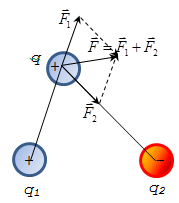 

Dividing by q, we obtain

Principle of superposition (overlay) fields:
Intensity  of
resulting field created by a system of charges, equal to the geometric
(vector) sum of the field intensities produced at this point each of
the charges separately. of
resulting field created by a system of charges, equal to the geometric
(vector) sum of the field intensities produced at this point each of
the charges separately.
Electrostatic field can be represented very clearly with lines of Intensity or power lines of vector  . .
Field line intensity vector  is a curve whose tangent at every point in space coincides with the direction of the vector is a curve whose tangent at every point in space coincides with the direction of the vector  . .
The principle of construction of power lines  : :
- The lines of force vector
 begin on positive charges and terminate at negative (ie directed from "+" to "-") . begin on positive charges and terminate at negative (ie directed from "+" to "-") .
- The lines of force vector
 approach the surface charges at right angles . approach the surface charges at right angles .
3. For a quantitative description of the vector Е field lines
carried out with a certain density. The number of lines of intensity
running through the unit area perpendicular to the lines of intensity
must be equal to the modulus of a vector  . .
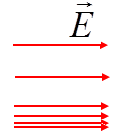  Homogeneous is a field that has a vector Homogeneous is a field that has a vector  in any point in space is constant in magnitude and direction, ie vector in any point in space is constant in magnitude and direction, ie vector  parallel to the field lines and their density is constant at all points parallel to the field lines and their density is constant at all points

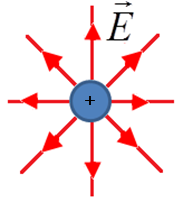 
Painting lines isolated point charges
§ 4 'Dipole.
Dipole moment.
Dipole field
Electric dipole is a system of two point-of opposite charges (+ and -) at a distance ℓ.
Vector along the dipole axis (the line passing through the two charges)
from the negative to the positive charge and is equal to the distance
between them, called the ARM dipole . .
.
vector

coinciding with the direction of the dipole arm and the product of the charge q on the arm  is called an electric dipole moment is called an electric dipole moment  or dipole moments . or dipole moments .

By the principle of superposition the field intensity Е of dipole at any point

 - field generated by a positive charge, - field generated by a positive charge,  - the field of negative charge. - the field of negative charge.
Field intensity on the extension of the axis of the dipole
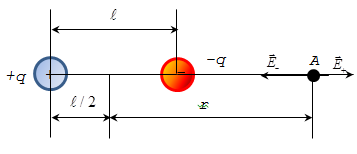

 because because 
- The field intensity at a perpendicular to the axis of the reconstructed from his middle
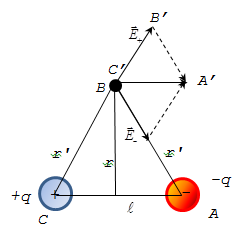 

Triangle A'B'C 'similar to the triangle ABC, as equilateral and three angles are equal, so
 

The picture of the dipole field lines:

|












